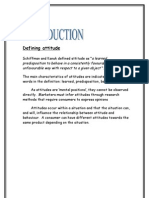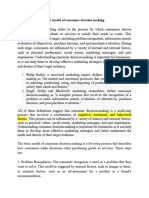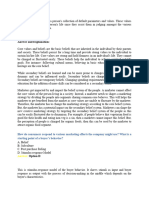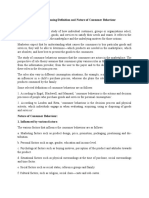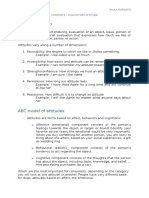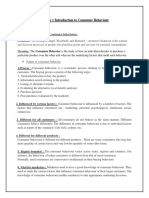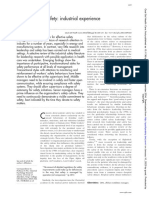An atude is how we feel abou somehing based on our experiences and beliefs. I shapes how wereac o hings in our surroundings. When we have an atude abou somehing, i makes us likely orespond in a cerain way.
Simple Explanaton:
Wha i is
: Atudes are feelings we have abou hings, like producs or brands. They come fromwha we've learned or experienced.
How i works
: If we have a posive atude owards somehing, we end o like i and suppori. If we have a negave atude, we migh avoid i or dislike i.
Example Relaed o Consumers:
Imagine a person who has a posive atude owards a cerain brand of sneakers because hey had agrea experience wih hem in he pas. They nd hem comforable, sylish, and durable. Because ofhis posive atude, when i's me o buy new shoes, hey are more likely o choose ha brand againand recommend i o friends.On he oher hand, if someone had a bad experience wih a specic resauran—maybe he food wascold or he service was slow—hey migh develop a negave atude owards ha resauran. As aresul, hey would be less likely o go back, even if someone invies hem or if he resauran has newmenu iems.In boh cases, atudes inuence consumer choices and behaviors.Atudes consis of hree main componens: cognive, aecve, and behavioral. Here’s a simplebreakdown of each componen along wih heir imporance in undersanding atudes, especially in aconsumer conex.
1. Cognitve Componen
Wha i is
: This refers o he beliefs and houghs we have abou an objec or issue.
Example
: A consumer believes ha a parcular smarphone brand is high-qualiy and reliablebased on reviews and research. Their undersanding of he produc inuences heir atudeowards i.
2. Afectve Componen
Wha i is
: This is abou he feelings or emoons we have owards an objec or issue.
Example
: A person feels excied and happy abou a new video game release because hey haveenjoyed he previous games from ha franchise. This emoonal response shapes heir atudeowards buying he game.
3. Behavioral Componen
Wha i is
: This relaes o he way we ac or behave owards an objec or issue.
Example
: If someone has a posive atude owards a brand of organic food, hey are morelikely o purchase hose producs regularly and promoe hem o friends and family.
Componen Consisency
Wha i means
: This refers o how he hree componens (cognive, aecve, and behavioral)align wih one anoher. Consisency means ha if someone has posive beliefs (cognive) andposive feelings (aecve) abou a brand, hey are likely o behave posively owards i(behavioral) as well.
Example o Consisency
: If a consumer believes ha eco-friendly producs are beer for heenvironmen (cognive) and feels good abou using hem (aecve), hey are likely o buy eco-friendly producs regularly (behavioral). Inconsisen atudes migh occur if someone believes abrand is high-qualiy (cognive) bu has negave feelings owards i (aecve), leading ohesiaon in making a purchase (behavioral).The
cognitve componen
of atudes is crucial in shaping consumer behavior. I involves he beliefs andknowledge ha a consumer has abou a parcular brand, produc, or oule. Here’s a simpleexplanaon, along wih deails on beliefs, evaluaons of aribues, and he mul-aribue model.
Cognitve Componen Explained
1.
Belies and Knowledge
:
o
This componen includes everyhing a consumer hinks hey know abou a produc orbrand. I can be based on personal experiences, adversemens, reviews, and word-of-mouh.
o
Example
: A consumer may believe ha Brand X sneakers are more durable han Brand Ybased on reviews hey’ve read.2.
Evaluaton o Aribues
:
o
Consumers evaluae various aribues (feaures or characeriscs) of a produc whenforming beliefs. These aribues can include price, qualiy, design, and performance.
o
Example
: When looking a a smarphone, a consumer migh consider baery life,camera qualiy, and sorage capaciy. Their evaluaons of hese aribues conribue oheir overall belief abou he smarphone.3.
Summaton o Evaluatons
:
o
The cognive componen reecs he oaliy of hese evaluaons. Consumers mayweigh he imporance of each aribue dierenly based on heir needs andpreferences.
o
Example
: If a consumer priorizes camera qualiy over price when considering asmarphone, heir belief abou he brand will largely depend on how hey evaluae hecamera feaure.
Mult-Aribue Model
The mul-aribue model is a framework ha helps undersand how consumers form atudesbased on heir evaluaons of mulple aribues. I assumes ha consumers consider variousaribues of a produc, each weighed according o is imporance.
How I Works:
1.
Lis Aribues
: Idenfy key aribues relevan o he produc.2.
Evaluae Each Aribue
: Rae how well each brand or produc performs on hese aribues.3.
Weigh Imporance
: Assign imporance weighs o each aribue based on personal preference.4.
Calculae Overall Aude
: The overall atude owards a brand can be calculaed using aformula ha combines he evaluaons and heir respecve weighs.
Example:
For a lapop purchase:
Aribues Considered
: Baery life, price, weigh, brand repuaon.
Evaluatons
:
o
Brand A: Baery life (4/5), Price (3/5), Weigh (5/5), Repuaon (4/5)
o
Brand B: Baery life (5/5), Price (4/5), Weigh (3/5), Repuaon (3/5)
Imporance Weighs
:
o
Baery life: 40%
o
Price: 30%
o
Weigh: 20%
o
Repuaon: 10%Using he mul-aribue model, he consumer calculaes an overall score for each brand based on heirevaluaons and he imporance weighs, helping hem make an informed decision.This cognive evaluaon process inuences atudes and ulmaely drives purchasing behavior, makingi a crical area for markeers o undersand and leverage.The
afectve componen
of atudes is all abou he feelings and emoons ha consumers associaewih a produc or brand. Here’s a simple breakdown of is key aspecs, including how i relaes oexperience, cognion, individual siuaons, and culural inuences.
Afectve Componen Explained
1.
Feelings and Emotonal Reactons
:
o
The aecve componen reecs how consumers feel abou a produc, which can rangefrom posive feelings (like love, exciemen, or rus) o negave feelings (like dislike,anger, or fear).
o
Example
: A consumer may feel joy and exciemen when hinking abou a brand of icecream hey loved as a child.2.
Based on Experience or Cognitve Inormaton
:
o
Emoons can arise from direc experiences (like using a produc) or from cogniveinformaon (such as adversemens or reviews).
o
Example
: If a consumer has a grea experience wih a parcular brand of car, hey maydevelop a posive emoonal reacon oward ha brand. Conversely, if hey hearnegave reviews, hey migh feel apprehensive or fearful abou buying ha brand.3.
Person-Siuaton Specic
:
o
Emoonal responses can vary depending on he individual and he siuaon. Dierenconsumers may reac dierenly o he same produc based on heir personalexperiences and conexs.
o
Example
: One person migh feel nosalgic abou a classic oy because i reminds hem ofheir childhood, while anoher migh have no emoonal aachmen o i a all.4.
Culural Inuence
:
o
Culural background can signicanly shape emoonal reacons o producs. Dierenculures may have varying values, radions, and symbols ha inuence how consumersfeel abou cerain brands or producs.
o
Example
: In some culures, luxury brands may evoke feelings of presge and saus,while in ohers, hey migh be viewed wih skepcism or as unnecessary. For insance, abrand promong environmenal susainabiliy migh resonae posively wih consumersin culures ha priorize eco-friendliness.
Imporance o he Afectve Componen
The aecve componen plays a vial role in consumer decision-making. Posive feelings owards abrand can lead o brand loyaly, while negave feelings can deer purchases. Markeers oen ap inoemoons in heir adversing o creae srong connecons wih consumers, enhancing he overall brandexperience.
Summary
The aecve componen highlighs he emoonal side of consumer behavior, showing how feelings,experiences, and culural inuences conribue o atudes oward producs. Undersanding hiscomponen helps markeers design campaigns ha resonae emoonally wih heir arge audience,ulmaely driving consumer engagemen and loyaly.













